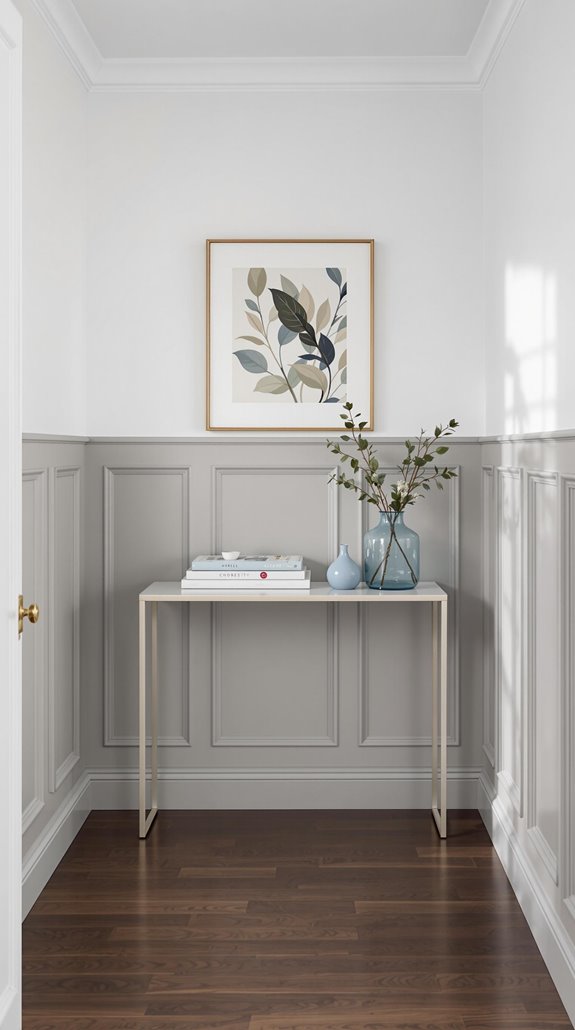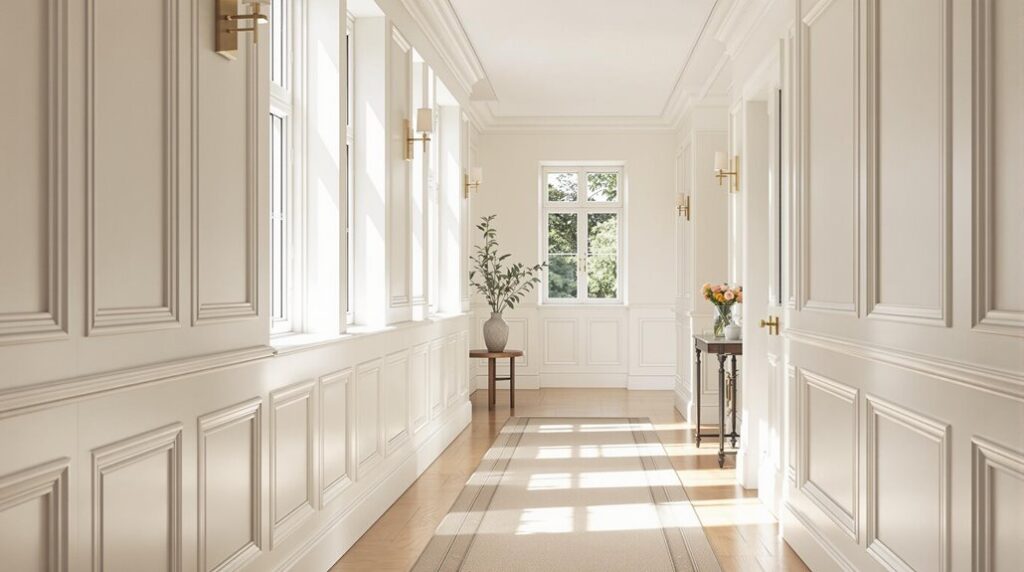I’ve helped dozens of UK homeowners transform their hallways from forgettable passageways into stunning focal points, and wainscoting consistently delivers the most dramatic results. Whether you’re dealing with a narrow Victorian terrace corridor or a sprawling country home entrance, the right wainscoting design can add instant architectural character while solving practical problems like scuff marks and cold walls. The key lies in choosing the style that complements your home’s existing features and your personal aesthetic preferences.
Key Takeaways
- Wainscoting transforms UK hallway walls into sophisticated architectural features while protecting against daily wear and moisture damage.
- Popular styles include raised panel for traditional homes, flat panel for modern aesthetics, and beadboard for cottage charm.
- Maintain 36-42 inch heights and use vertical lines in narrow hallways to create visual harmony and elongate space.
- Choose durable materials like MDF or wood veneer, with semi-gloss paint finishes for high-traffic hallway areas.
- Neutral colors like off-whites and light grays offer timeless elegance, while dark navy creates sophisticated contrast with white.
What Is Wainscoting and Why Choose It for Your Hallway
Wainscoting transforms ordinary hallway walls into sophisticated architectural features through the strategic application of wooden panels or modern materials. I’ll explain why this 13th-century technique has become essential for UK homeowners seeking both function and style.
Originally designed for insulation against cold stone walls, wainscoting now serves dual purposes in modern homes. It protects your hallway walls from daily wear—scuffs from bags, scratches from furniture, and moisture from wet coats. The paneling reinforces structural integrity while creating wipeable surfaces that handle high-traffic demands.
Beyond protection, wainscoting elevates your hallway’s aesthetic appeal. It adds visual depth and texture to plain walls, creates the illusion of higher ceilings, and provides architectural interest that transforms transitional spaces into welcoming focal points that reflect your refined taste. During the English Renaissance, this technique evolved from purely functional insulation to incorporate decorative elements that enhanced interior design.
Transform Your Hallway With These Popular Wainscoting Styles
Five distinct wainscoting styles can transform your hallway from a simple passageway into an architectural showcase, each offering unique visual impact and practical benefits.
I’d recommend raised panel wainscoting for traditional homes, featuring ornate quarter-sawn oak profiles that add formal grandeur. For modern aesthetics, flat panel (Shaker) wainscoting delivers clean lines and scuff resistance—perfect for busy corridors when painted in soft greys. Investing in property can also be an effective strategy for enhancing your home’s value through renovations like wainscoting.
Beadboard brings cottage charm with vertical grooved planks, though you’ll need regular dusting maintenance. Board and batten creates bold contrast through two-tone schemes, with battens spaced 12-18 inches apart for visual rhythm.
Contemporary styles offer streamlined profiles with unconventional finishes like matte black, extending ceiling-height for dramatic emphasis. Overlay wainscoting combines flat panels with decorative molding for a sophisticated and intricate appearance. Each style serves different architectural visions while protecting your walls.
Essential Design Tips for Hallway Wainscoting Success
While selecting the right wainscoting style sets the foundation, proper execution depends on mastering key design principles that’ll make or break your hallway transformation.
I recommend maintaining 36-42 inch heights for visual harmony with light switches. In narrow hallways, prioritize vertical lines to elongate space—avoid horizontal emphasis that’ll compress your corridor. Additionally, achieving a flawless finish on your wainscoting can be enhanced by applying two coats of paint for added durability and uniformity.
Match your wainscoting style to your home’s architecture. Traditional homes suit raised panels, while modern spaces benefit from clean, flat designs. Light colours like white or cream brighten narrow passages and create spacious perception. Plan around electrical outlets and align top rails with existing architectural elements for seamless integration. Use semi-gloss paint for durability in high-traffic areas, and guarantee uniform height throughout connected hallways to maintain flow. Wainscoting adds texture and visual interest to hallways while enhancing the overall design aesthetic. These fundamentals assure professional results.
Materials and Installation Guide for UK Homeowners
Your design success hinges on choosing the right materials and executing proper installation techniques. I’ll guide you through the essential options available to UK homeowners.
For materials, consider MDF for affordability and workability, or moisture-resistant MDF for kitchens and bathrooms. Wood veneer offers natural beauty, while PVC provides durability with minimal maintenance. Wood-veneered MDF combines aesthetic appeal with structural stability and can be a cost-effective option when considering renovation costs for your project.
Before installation, assess your walls for imperfections and fill any holes to guarantee smooth surfaces. Measure accurately and gather necessary tools including saws, levels, adhesive, and fixings.
For installation, use construction adhesive on prepared surfaces or mechanical fixings for heavier panels. Cut panels to fit around architectural features and maintain alignment with a level. Standard panel dimensions are typically 780mm length x 600mm height, making them ideal for creating accent walls as striking focal points. Regular cleaning with damp cloths guarantees long-lasting results.
Color Schemes and Décor Ideas That Work

The transformation of your hallway begins with selecting the right colour scheme for your wainscoting. I recommend neutral off-whites, natural blues, or light grays for timeless elegance that works with any décor style. Adding extra living space through thoughtful design can also enhance the overall appeal of your home.
For dramatic impact, I suggest pairing dark navy or chocolate brown wainscoting with crisp white upper walls. This creates sophisticated contrast whilst hiding scuffs in high-traffic areas. If you’re working with a narrow hallway, Pure White from Sherwin Williams brightens the space effectively.
Consider your wainscoting style when choosing colours. Flat panels suit soft pastels for Scandinavian aesthetics, whilst beadboard pairs beautifully with coastal blues and whites. Board and batten looks striking with dark grey paneling below and white walls above, creating visual height in cramped spaces. Sea Pearl from Benjamin Moore offers cool gray undertones that work exceptionally well with white wainscoting to create beautiful contrast.
Budget-Friendly Wainscoting Options and Where to Buy
Creating beautiful wainscoting doesn’t require breaking your budget, and I’ll show you practical options that deliver professional results without the premium price tag. Incorporating budget-friendly tips can enhance the overall look while saving costs.
Beadboard panels offer excellent value with fewer prominent edges that resist dents. Multi-functional mouldings like No.157 from LLCompany serve multiple purposes, reducing your material costs considerably.
Installation’s straightforward: outline frames with a pen, apply wood glue to panel backs, then nail at 10-inch spacing starting from corners. You’ll need a jigsaw for outlet cuts. Remember to remove existing outlet covers before beginning your installation process.
Focus on high-impact areas like entries, hallways, and dining rooms where wainscoting provides both protection and visual appeal at chair height.
For UK suppliers, LLCompany offers extensive wainscoting selections, while Amazon UK provides essential tools through affiliate links for complete project solutions.
Conclusion
I’ve covered the essentials for installing wainscoting in your UK hallway. You’ll find that proper planning and material selection make the difference between amateur and professional results. Don’t rush the measuring and cutting stages—precision here saves time later. Whether you choose MDF for budget-conscious projects or solid wood for premium appeal, focus on consistent spacing and secure mounting. Your hallway transformation starts with quality preparation and attention to detail.
References
- https://llcompany.co.uk/blogs/our-blog/what-is-wainscoting
- https://edwardgeorgelondon.com/7-hallway-panelling-ideas/
- https://www.houzz.com/photos/wainscoting-hallway-ideas-phbr1-bp~t_743~a_3406-20865
- https://www.homesandgardens.com/interior-design/wainscoting-ideas
- https://www.houzz.co.uk/photos/hallway-with-wainscoting-ideas-and-designs-phbr2-bp~t_10408~a_13-418–3406-20865?pg=2
- https://ovationco.com/2022/06/22/what-is-wainscoting/
- https://www.masterclass.com/articles/what-is-wainscoting
- https://foyr.com/learn/what-is-wainscoting-in-interior-designing
- https://www.housebeautiful.com/home-remodeling/diy-projects/a43840111/what-is-wainscoting/
- https://www.homelight.com/blog/what-is-wainscoting/

